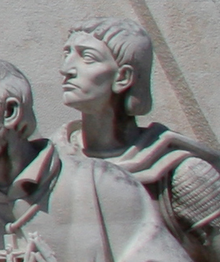Cristóvão da Gama
| Cristóvão da Gama | |
|---|---|

|
|
| Born |
Cristóvão da Gama c. 1516 Évora, Kingdom of Portugal |
| Died | August 29, 1542 (aged 25–26) Wofla, Adal Sultanate |
| Nationality | Portuguese |
| Occupation | Military commander |
| Known for | Leader of a Portuguese military expedition in Ethiopia and Somalia |
| Parent(s) |
Vasco da Gama Catarina de Ataíde |
| Signature | |
 |
|
Cristóvão da Gama (c. 1516 – 29 August 1542), anglicised as Christopher da Gama, was a Portuguese military commander who led a Portuguese army of 400 musketeers on a crusade in Ethiopia and Somalia (1541–1543) against the far larger Adal Muslim army of Imam Ahmad ibn Ibrahim al-Ghazi (also known as Ahmad Gurey) aided by the Ottoman Empire. He (along with the allied Ethiopian army) was victorious against larger forces in four battles, but was seriously wounded in his last battle, after which he was captured and eventually executed. Sir Richard Burton, in his First Footsteps in East Africa, referred to him as "the most chivalrous soldier of a chivalrous age."
Cristóvão (or Christopher) da Gama was the son of Vasco da Gama and younger brother of Estêvão da Gama. He first came to India in 1532 with his brother, returned to Portugal in 1535, then joined Garcia de Noronha in sailing to Diu 6 April 1538. Many times in these travels he demonstrated a quick mind that saved his companions. In recognition of his usefulness, in 1541, his brother Estêvão, then Viceroy of India, gave him command of a ship in the fleet Estêvão led into the Red Sea against the Ottoman naval base at Suez.
Estêvão's raid came to nothing, and he returned to Massawa on May 22, 1541, to rejoin the ships he had left there. While at Massawa, he attempted to salvage something from this raid by dispatching an expeditionary force under Cristóvão to assist the beleaguered Emperor of Ethiopia, Gelawdewos. Four hundred Portuguese men-at-arms were selected, seventy of whom were also skilled artisans or engineers, and 130 slaves for this expedition, equipped with about a thousand arquebuses, an equal number of pikes and several bombards.João Bermudes, who had represented himself as the patriarch of Ethiopia to the Portuguese, accompanied this expedition. An account of this campaign in the Ethiopian highlands was later written by Miguel de Castanhoso, who accompanied Gama and was an eye-witness to almost everything he recorded. The men were landed at Massawa and Arqiqo, the next port south of Massawa, and began their trek inland to Debarwa, the capital of the Bahr negus, or Ethiopian viceroy for the northern provinces.
...
Wikipedia
